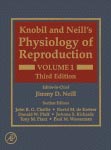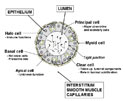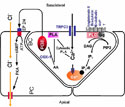Chapter 22 - The Epididymis
B Robaire, BT Hinton, MC Orgebin-Crist
Plates (3rd Edition)
Note: This section includes only the colored plates that do not appear in the 3rd Edition of the book.
Erratum: Figure 11 should have been acknowledged as follow: (Reproduced with permission from Turner, T.T. [2002]. Necessity's potion: inorganic ions and small organic molecules in the epididymal lumen. In The Epididymis: From Molecules to Clinical Practice [B. Robaire and B.T. Hinton, Eds.], pp. 131-150. Kluwer Academic/Plenum, New York.). Our apologies.
Fig. 4
Schematic organization of the major cell types in the epididymis as observed at the light microscope
Fig. 10
Fertilizing capacity of mouse spermatozoa from successive segments of the epididymis inseminated either in vivo or in vitro with cumulus-encased or cumulus-free ova, with intact ova, zona-free ova, after zona drilling, or subzonal sperm injection
Fig. 13
Representative examples of the checkerboard pattern of expression seen immunohistochemically along the epididymis
Fig. 15
Schematic diagram illustrating the roles of COX-1 and Trp3 in the regulation of principal cell functions by basal cells in the rat epididymis





